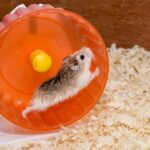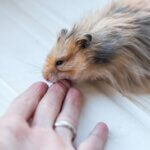Last Updated on: 2nd January 2024, 10:01 pm
Hamsters are active creatures that love to explore their cage, burrow in their bedding, and run on their wheels. They’re crepuscular animals and most active between dusk and nighttime.
While running around in circles is sometimes considered normal, it can signify a health problem, especially if the hamster tilts its head at the same time.
Why Does My Hamster Keep Running in Circles?
Hamsters love to explore their enclosures, searching for food and discovering new toys. There are many reasons why hamsters run in circles, most of which are normal:
Burning Energy
Wild hamsters can run as much as they want, but the enclosures they’re kept in as pets limit their ability to run with such abandon.
They need to burn off their energy, so they sometimes run in circles or back and forth from one end of their cage to another. After all, these are the limits of their living environment.
Hungry
If a hamster’s food supply is low or it’s hungry after eating, it may run in circles searching for food.
Bored
Hamsters are naturally active and curious creatures that love exploring their surroundings and searching for discoveries. If a hamster runs in circles a lot, it could be due to boredom.
Put some new toys in its cage and see if it settles the hamster.

Uncomfortable
If it’s too cold or hot, a hamster may run in circles because it’s uncomfortable. Hamsters prefer temperatures in the 65-75 degrees Fahrenheit range.
Illness
Running in circles indicates that a hamster has a health issue.
What Illnesses Cause Hamsters to Run in Circles?
Several illnesses and afflictions can cause a hamster to run in circles, including:
Ear Infections
Hamsters are susceptible to inner and middle ear infections. An ear infection occurs when bacteria enter the ear canal, which exerts pressure in the ear, throwing hamsters off balance.
Because they feel off balance, hamsters may develop a head tilt and run in circles.
According to the World Small Animal Veterinary Association, indications of ear infections in small animals include pain, head shaking, ear discharge, ear scratching, and head tilt.
Ear Mites
Ear mites like Demodex criceti and Demodex aurati are parasites that feed on the wax and oils in the ear canal, leading to irritation and inflammation. This can cause disorientation and circling behavior.
Neurological Disorders
There are several neurological disorders hamsters can develop that cause circling:
Hamster Circling Disorder
This neurological brain disorder is passed on genetically from the parent hamster to its offspring.
It’s characterized as an obsessive-compulsive disorder (OCD), which causes hamsters to run in circles uncontrollably. A hamster with Hamster Circling Disorder will exhibit signs when 3 months old.
Stargazing
Stargazing is a neurological disorder that causes hamsters to stand on their back legs and stare upward or stargaze and do back flips.
Hamsters with this disorder might also compulsively pace back and forth in their cage or run in a stationary circle.
Strokes
Strokes are caused by blood vessels in the brain becoming blocked or leaking. Blockages cut off the blood supply to parts of the brain, which causes a stroke.
Leaking blood vessels decreases the supply of blood going to the brain, which can still cause a stroke, but the symptoms are less severe, sometimes only temporary.
In hamsters, strokes can cause head tilts. Unlike temporary head tilts caused by ear infections, head tilts caused by strokes are usually permanent.
Running in circles can be a side effect of a stroke due to loss of equilibrium and mental confusion.
Strokes in hamsters can cause paralysis. Sometimes, the paralysis is only temporary, but it can take weeks after a stroke before hamsters regain their movement.
You’ll have to hand-feed the hamster and ensure it stays hydrated.
Seizures
Hamsters can begin having seizures due to a variety of ailments. Diabetes, brain injury or trauma, strokes, ear infections, and poisoning can cause seizures in hamsters.
Hamsters that experience seizures may have difficulty walking. They’ll run in circles, have a head tilt, collapse, or fall on their back.
Environmental Factors And Hamster Behavior
Hamsters have mood swings, which sometimes change their behaviors. In addition, environmental factors can play a part in a hamster’s mood and behavior.
Changing Light-Dark Cycles
BMC Neuroscience studied hamsters’ behavior based on different light-dark cycles and how their behavior changed based on whether they were in darkness or dim light during the dark cycle.
Scientists altered the lengths of the light-dark cycles by lengthening the time the hamsters were in light cycles, shortening the dark cycles, and vice versa.
This alteration had a definite impact on the behavior pattern of the hamsters, with some growing accustomed to light-dark patterns.
Hamsters most active during the dark cycle did more in dim light than in total darkness. The hamsters that adjusted well to the longer daylight cycle increased their activity at those times.
This makes sense, considering that Biology Letters Animal Behaviour stated that hamsters are crepuscular creatures only in captivity (not in the wild).
Wild hamsters are primarily diurnal, meaning they’re awake during the day and sleep at night.
Based on this information, we can assume that hamsters’ days and nights can change, disrupting their sleep cycles and causing changes in their behaviors.

Noise and Commotion
If the hamster’s cage is placed in an area of your home with lots of noise and commotion, it can cause stress and cause behavior changes in your hamster.
Either limit the noise or move your hamster’s cage to a different, quieter area of your home.
Sudden noises can also startle and scare your hamster. You may notice your hamster retreats into a corner or burrows into its bedding to hide because it’s scared.
Injuries
When hamsters are picked up, played with, and allowed to roam outside their cage, their chances of getting injured are greater.
The hamster could get dropped, stepped on, could fall from a high surface, or something could fall on it. Any of these accidents can cause injuries to a hamster.
The accident could scare the hamster even if it hasn’t been seriously injured. You might find the hamster hiding in the corner of its cage or burrowing deep in its bedding material.
Cage Size
If the hamster’s cage is too small, it can cause behavioral issues.
You may observe the hamster pacing, spinning in circles, squeaking, or hissing at you whenever you come near or reach into the cage. The hamster may lose its appetite, become less active, and sleep more.
Get a larger cage to house the hamster and see if its behavior modifies.





